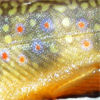At the tip of the noses of mammals, including humans, is a ball of nerve cells known as the Grueneberg ganglion, named after Hans Grueneberg, the scientist who described the structure in mice in 1973. But they still did not know what the ganglion smelled. Researchers at the University of Lausanne in Switzerland report that they have figured it out.
All sorts of organisms, including plants, insects and mammals, release “alarm pheromones” when they sense danger; the pheromones waft through the air to warn others. Very little is known about the alarm pheromones of mammals other than that they exist. Scientists have not identified the compounds; they do not know where in the body the pheromones are produced. Nonetheless, the Lausanne scientists could collect the pheromones by simply stressing mice and sucking up the air around them.
When other normal mice were exposed to the danger-scented air, they froze in their tracks. But mice whose Grueneberg ganglia had been excised did not notice anything wrong and continued to wander around their cages without a care in the world. (Para from NYTIMES)
I have always wondered about this. When one catches a fish and the fight is on do you think they telecast, by some sort of chemical a warning alarm to other fish that danger is near or eminent and to stay clear? It might just be a possibility.
REALTIME FLOWS  U. Kern: n/a cfs
U. Kern: n/a cfs
 L. Kern: 1341 cfs
L. Kern: 1341 cfs
 E.W: 312 cfs
E.W: 312 cfs
 U. Owens: 108 cfs
U. Owens: 108 cfs  L. Owens: 496 cfs 09/02/19 1:15 PM PST
L. Owens: 496 cfs 09/02/19 1:15 PM PST
Alarm fear in fish?
10 posts
• Page 1 of 1
Alarm fear in fish?
EVERY DAY A VICTORY, EVERY YEAR A TRIUMPH
- fflutterffly
- Posts: 1787
- Joined: March 16th, 2008, 6:50 am
- Location: Los Angeles, CA
Re: Alarm fear in fish?
I have not heard that about Trout, but have read/heard that, if while stalking carp you spook one fish in the pod, even if the pod is not tightly spread, the entire pod will be put down. This was supposed to be due to pheromones. Good info Ariel. Since finding that out about carp, I have often wondered about the same in trout.
How do you tie the fly to your hooks without killing them with the thread? I keep cutting them in half.
-

darrin terry - Posts: 3369
- Joined: July 26th, 2008, 8:47 am
- Location: Locale: NoCal
Re: Alarm fear in fish?
Hmmm this is a very interesting subject; I think I might have to look into it. It could also be the fact that they are picking up the vibrations from their lateral lines they do not have to be tightly schooled to sense the vibrations.
-

Sasha - Posts: 3885
- Joined: July 11th, 2008, 10:42 pm
- Location: The 208
Re: Alarm fear in fish?
I recall a New Zealand video (or was it his book?) where the guide (Chappie Chapman I believe) has observed large fish cowering after smelling disturbed water from anglers a good distance upstream. I have yet to put this concern into my list of cautions for a brown trout hunt but it is interesting and I am not prepared to doubt him.
B
B
-

Bernard - Posts: 1413
- Joined: July 21st, 2008, 7:07 pm
- Location: Southern California - Most of the time ...
Re: Alarm fear in fish?
Yeah, I definitely know they can smell. I still talk to people who don't realize they have noses, but you can see the nostrils or equivalent just in front of their eyes.
In this article found on MidCurrent.com Zach Matthews talks about carp and the alarm pheromones they release in addition to a bunch of other good info. Good read:
http://www.midcurrent.com/articles/tech ... _carp.aspx
By the way, if anyone has not checked them out, Zach has a very cool set of podcasts available through iTunes Music Store. They are free and generally run about 45-60 minutes. Interviews with some very cool and knowledgeable people in the world of flyfishing. I think they can also be downloaded from his site, the ItinerantAngler. The forum there is pretty cool. Obviously not as local, being based out of Atlanta, GA, but some really good info there and there are some members who are well known in the industry, several guides and such as well as a great photography section with a good number of professional and published photographers.
Boy, that turned into a plug.
If anyone has info pointing to trout releasing alarm pheromones, I'd like to hear it. More info is always good.
In this article found on MidCurrent.com Zach Matthews talks about carp and the alarm pheromones they release in addition to a bunch of other good info. Good read:
http://www.midcurrent.com/articles/tech ... _carp.aspx
By the way, if anyone has not checked them out, Zach has a very cool set of podcasts available through iTunes Music Store. They are free and generally run about 45-60 minutes. Interviews with some very cool and knowledgeable people in the world of flyfishing. I think they can also be downloaded from his site, the ItinerantAngler. The forum there is pretty cool. Obviously not as local, being based out of Atlanta, GA, but some really good info there and there are some members who are well known in the industry, several guides and such as well as a great photography section with a good number of professional and published photographers.
Boy, that turned into a plug.
If anyone has info pointing to trout releasing alarm pheromones, I'd like to hear it. More info is always good.
How do you tie the fly to your hooks without killing them with the thread? I keep cutting them in half.
-

darrin terry - Posts: 3369
- Joined: July 26th, 2008, 8:47 am
- Location: Locale: NoCal
Re: Alarm fear in fish?
Here is an interesting article on the subject but it is a bit old. I will look for more information on the subject when I am not at work. I will also try to get a hold of my buddy who is a marine biologist and see if he has any additional information on this subject
http://www.colostate.edu/Depts/Entomolo ... bosio.html
ETA: I found this PDF on an experiment they did on Oncorhynchus mykiss (AKA Rainbow Trout)
http://pubs.nrc-cnrc.gc.ca/rp/rppdf/z02-216.pdf
http://www.colostate.edu/Depts/Entomolo ... bosio.html
ETA: I found this PDF on an experiment they did on Oncorhynchus mykiss (AKA Rainbow Trout)
http://pubs.nrc-cnrc.gc.ca/rp/rppdf/z02-216.pdf
-

Sasha - Posts: 3885
- Joined: July 11th, 2008, 10:42 pm
- Location: The 208
Re: Alarm fear in fish?
Another pdf with some interesting information (ok I will stop and get back to work  )
)
http://www.mnstate.edu/wisenden/pdfs/20 ... 059-67.pdf
http://www.mnstate.edu/wisenden/pdfs/20 ... 059-67.pdf
-

Sasha - Posts: 3885
- Joined: July 11th, 2008, 10:42 pm
- Location: The 208
Re: Alarm fear in fish?
Sounds like something you could at least use as an excuse if you get skunked:
"yeah, the fish were cowering in fear today because they smelled me coming"
"yeah, the fish were cowering in fear today because they smelled me coming"
Nature always wins.
> miles = < people
Camp in the mountains, not the left lane!

> miles = < people
Camp in the mountains, not the left lane!

-

Papasequoia - Posts: 4655
- Joined: July 5th, 2008, 10:14 pm
- Location: East Side of the Sierra Nevada
Re: Alarm fear in fish?
Nonw that would would have had the water flowing out my nose, Jon. My luck, I had just picked up the cup.
How do you tie the fly to your hooks without killing them with the thread? I keep cutting them in half.
-

darrin terry - Posts: 3369
- Joined: July 26th, 2008, 8:47 am
- Location: Locale: NoCal
Re: Alarm fear in fish?
I do know that Trout do not have as refined olfactory sensor/nerves as other fish, Bass for example and therefore their Laterial line is their window to the world. As with their sight, which is not reputed to be the greatest, being limited to a specific area related to the depth. When I first started fly fishing I couldn't believe the 'hype' that fish can see color extremely well and that trout like certain color. I argued that the brain of a trout lacked the sophistication needed to translate the information, and that trout lacked the rods and cones needed. WHAT A DUMBASS I AM! Turns out that trout, specifically, have an abundance of cones and tones of nerve endings to prove it! As a matter of FACT, their little puny brain skull area is home to just this stuff. Go Figure. ( I am such a dumbass.) Wait is that Dumb butt or Dum Bass? (http://www.fish.state.pa.us/newsrelease ... hsense.htm) (http://www.bcadventure.com/ronnewman/rainbow.phtml) Just to name a few ref. sites.
EVERY DAY A VICTORY, EVERY YEAR A TRIUMPH
- fflutterffly
- Posts: 1787
- Joined: March 16th, 2008, 6:50 am
- Location: Los Angeles, CA

